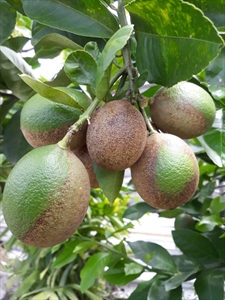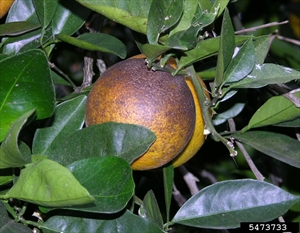Citrus rust mite
Pacific Pests, Pathogens, Weeds & Pesticides - Online edition
Pacific Pests, Pathogens, Weeds & Pesticides
Citrus rust mite (344)
Phyllocoptrata oleivora; previously known as Eriophyes oleivorus.
Asia, Africa, North, South and Central America, the Caribbean, Europe, Oceania. It is recorded from Australia, Cook Islands, Fiji1, and New Zealand.
Citrus species.
A microscopic mite does the damage; it feeds on the rind of fruit killing the cells causing the fruit to become slightly rough, and turn silvery (grapefruit and lemons) (Photo 1), reddish or black (oranges) (Photo 2). The fruit may be smaller than usual, and do not store well. In heavy infestations, leaves and green twigs bronze, and trees are less vigorous. The mites prefer the side of the fruit facing the sun; consequently, fruit damage is greater on the outside of the tree.
Females lay about 30 eggs singly in pits or depressions in the leaves and fruit, or in cracks in the bark. The nymphs are similar to the adults, but paler and slimmer. The adults are yellow to yellow-brown, wedge or spindle-shaped, with two pairs of legs (Photo 2). The female is about 0.15 mm long, slightly longer than the males, and too small to be seen with the unaided eye. The life cycle is from 7 to 10 days depending on the temperature. The mites prefer warm, humid weather.
Spread occurs locally in rain splash, and over greater distances on wind currents, birds, insects, machinery, and clothing of human beings. It also spreads with the trade in plants and plant parts, both domestically and internationally.
Considered an important pest in some countries (e.g., Australia, Argentina, China, Egypt) as it can reduce size, weight and quality of fruit, juice content, and increase fruit drop.
Look for the mites using a hand lens (x10 or higher magnification). Examine small fruit on inside of the canopy, looking at the stem end of the fruit, in particular. Look to see if the mites are all over the fruit; if so, numbers of mites are high. If damage is seen, that means that large numbers of mites are present already, and it may be too late to spray.
NATURAL ENEMIES
Predatory mites, Amblyseius species, keep population of the citrus rust mite in check. They are off-white, much large than the citrus rust mite, up to 0.4 mm, and can be seen with the naked eye along the side of veins, or under the calyx of the fruit (leaves at the stalk end). Predators, such as ladybird beetles are less effective until mites are numerous.
CHEMICAL CONTROL
Only consider using a pesticide before there are large infestations. But note, spraying will kill predatory mites and may upset biological control and make the situation worse. Only spray those trees where the infestation needs to be brought under control, not every tree if there is no need.
If pesticides are needed consider the following:
- Use lime sulphur (polysulphide sulphur) or wettable sulphur; leave at least 30 days between spraying lime sulphur and sprays of oil. Take care to follow manufactures' instructions as sulphur can burn the leaves.
- Alternatively, use white oil (made from vegetable oils), soap solution, or horticultural oil (made from petroleum) (see Fact Sheet no. 56).
-
White oil:
- 3 tablespoons (1/3 cup) cooking oil in 4 litres water.
- ½ teaspoon detergent soap.
- Shake well and use.
- Soap:
- Use soap (pure soap, not detergent).
- 5 tablespoons of soap in 4 litres water, OR
- 2 tablespoons of dish washing liquid in 4 litres water.
-
- Commercial horticultural oil can also be used. Usually, mite infestations are controlled using a number of low concentration (0.25-0.5%) oil sprays. White oil, soap and horticultural oil sprays work by blocking the breathing holes of insects and mites causing suffocation and death. There may be changes to feeding and egg-laying behaviour. Spray the undersides of leaves; the oils must contact the mites. A second application of soap or oils may be necessary after 3-4 weeks.
- Be careful to follow manufacturers' instructions if using a commercial horticultural oil or a white oil. Do not apply oils where temperatures are higher than 35°C or where trees are moisture-stressed. Never mix with other pesticides without checking compatibility.
- Alternatively, use abamectin, a miticide/insecticide, made from a soil bacterium.
____________________
When using a pesticide, always wear protective clothing and follow the instructions on the product label, such as dosage, timing of application, and pre-harvest interval. Recommendations will vary with the crop and system of cultivation. Expert advice on the most appropriate pesticides to use should always be sought from local agricultural authorities.
AUTHOR Grahame Jackson and Mani Mua
1Information from Swaine G (1971) Agricultural Zoology in Fiji. Her Majesty's Stationery Office. London; and CABI (2017) Phyllocoptrata oleivora (citrus rust mite) Crop Protection Compendium. (www.cabi.org/cpc); and Mite pests of citrus (1983) Agfacts NSW Agriculture. (http://www.dpi.nsw.gov.au/__data/assets/pdf_file/0006/138705/mite-pests-citrus.pdf); and Using petroleum-based spray oils in citrus (2005) Agfacts NSW Agriculture. (https://www.dpi.nsw.gov.au/__data/assets/pdf_file/0009/137646/petroleum-sprays-citrus.pdf); and from Citrus rust mite (silver mite) UC/IPM. Agriculture & Natural Resources, University of California Agriculture & Natural Resources. (http://ipm.ucanr.edu/PMG/GARDEN/FRUIT/PESTS/citrustmite.html). Photo 1 Don Ferrin, Louisiana State University Agricultural Center, Bugwood.org. Photo 2 Florida Division of Plant Industry, Florida Department of Agriculture and Consumer Services, Bugwood.org.
Produced with support from the Australian Centre for International Agricultural Research under project PC/2010/090: Strengthening integrated crop management research in the Pacific Islands in support of sustainable intensification of high-value crop production, implemented by the University of Queensland and the Secretariat of the Pacific Community.






